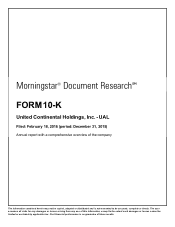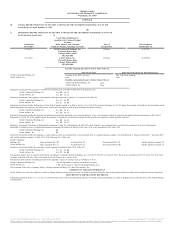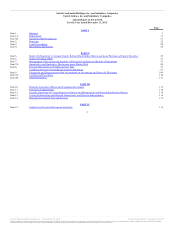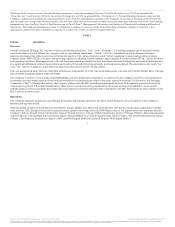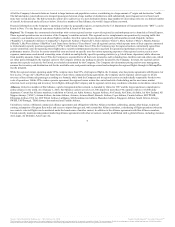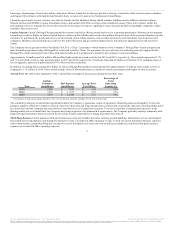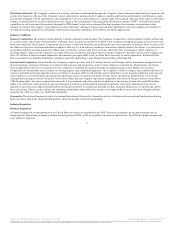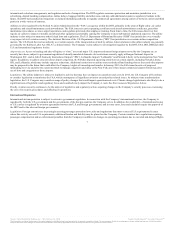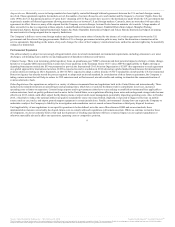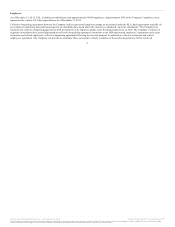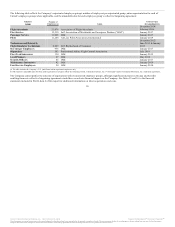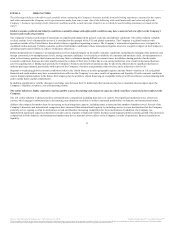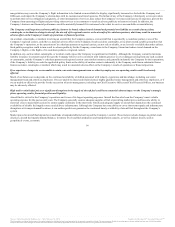United Airlines 2015 Annual Report Download - page 5
Download and view the complete annual report
Please find page 5 of the 2015 United Airlines annual report below. You can navigate through the pages in the report by either clicking on the pages listed below, or by using the keyword search tool below to find specific information within the annual report.
All of the Company’s domestic hubs are located in large business and population centers, contributing to a large amount of “origin and destination” traffic.
The hub and spoke system allows us to transport passengers between a large number of destinations with substantially more frequent service than if each
route were served directly. The hub system also allows us to add service to a new destination from a large number of cities using only one or a limited number
of aircraft. As discussed under below, United is a member of Star Alliance, the world’s largest alliance network.
Financial information on the Company’s operating revenues by geographic regions, as reported to the U.S. Department of Transportation (the “DOT”), can be
found in Note 17 to the financial statements included in Part II, Item 8 of this report.
Regional. The Company has contractual relationships with various regional carriers to provide regional jet and turboprop service branded as United Express.
These regional operations are an extension of the Company’s mainline network. This regional service complements our operations by carrying traffic that
connects to our mainline service and allows flights to smaller cities that cannot be provided economically with mainline aircraft. Republic Airlines
(“Republic”), CommutAir Airlines (“CommutAir”), ExpressJet Airlines (“ExpressJet”), GoJet Airlines (“GoJet”), Mesa Airlines (“Mesa”), Shuttle America
(“Shuttle”), SkyWest Airlines (“SkyWest”) and Trans States Airlines (“Trans States”) are all regional carriers, which operate most of their capacity contracted
to United under capacity purchase agreements (“CPAs”) with United. Under these CPAs, the Company pays the regional carriers contractually agreed fees
(carrier-controlled costs) for operating these flights plus a variable reimbursement (incentive payment for operational performance) based on agreed
performance metrics. The fees for carrier-controlled costs are based on specific rates for various operating expenses of the regional carriers, such as crew
expenses, maintenance and aircraft ownership, some of which are multiplied by specific operating statistics (e.g., block hours, departures) while others are
fixed monthly amounts. Under these CPAs, the Company is responsible for all fuel costs incurred as well as landing fees, facilities rent and other costs, which
are either passed through by the regional carrier to the Company without any markup or directly incurred by the Company. In return, the regional carriers
operate this capacity exclusively for United, on schedules determined by the Company. The Company also determines pricing and revenue management,
assumes the inventory and distribution risk for the available seats, and permits mileage accrual and redemption for regional flights through its MileagePlus
loyalty program.
While the regional carriers operating under CPAs comprise more than 95% of all regional flights, the Company also has prorate agreements with Hyannis Air
Service, Inc. (“Cape Air”), SkyWest and Trans States. Under these commercial flying agreements, the Company and its regional carriers agree to divide
revenue collected from each passenger according to a formula, while both the Company and its regional carriers are individually responsible for their own
costs of operations. Unlike CPAs, under a prorate agreement, the regional carrier retains the control and risk of scheduling, and in most cases, market
selection, local seat pricing and inventory for its flights, although the Company and its regional carriers may coordinate schedules to maximize connections.
Alliances. United is a member of Star Alliance, a global integrated airline network co-founded by United in 1997 and the largest and most comprehensive
airline alliance in the world. As of January 1, 2016, Star Alliance carriers served over 1,300 airports in more than 190 countries with over 18,500 daily
departures. Current Star Alliance members, in addition to United, are Adria Airways, Aegean Airlines, Air Canada, Air China, Air India, Air New Zealand, All
Nippon Airways (“ANA”), Asiana Airlines, Austrian Airlines, Avianca, Avianca Brasil, Brussels Airlines, Copa Airlines, Croatia Airlines, EGYPTAIR,
Ethiopian Airlines, EVA Air, LOT Polish Airlines, Lufthansa, SAS Scandinavian Airlines, Shenzhen Airlines, Singapore Airlines, South African Airways,
SWISS, TAP Portugal, THAI Airways International and Turkish Airlines.
United has a variety of bilateral commercial alliance agreements and obligations with Star Alliance members, addressing, among other things, reciprocal
earning, redemption of frequent flyer miles and access to airport lounges and, with certain Star Alliance members, codesharing of flight operations (whereby
one carrier’s selected flights can be marketed under the brand name of another carrier). In addition to the alliance agreements with Star Alliance members,
United currently maintains independent marketing alliance agreements with other air carriers currently unaffiliated with a global alliance, including Aeromar,
Aer Lingus, Air Dolomiti, Azul, Cape Air,
4
Source: United Continental Holdings, Inc., 10-K, February 18, 2016 Powered by Morningstar® Document Research℠
The information contained herein may not be copied, adapted or distributed and is not warranted to be accurate, complete or timely. The user assumes all risks for any damages or losses arising from any use of this information,
except to the extent such damages or losses cannot be limited or excluded by applicable law. Past financial performance is no guarantee of future results.

